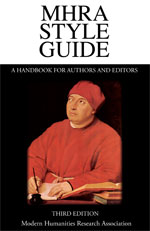MHRA Style Citation Demonstration
Click cover to enlarge | According to the MHRA Style Guide, this item should be cited in a bibliography as follows: Richardson, Brian (ed.), MHRA Style Guide: Third Edition (2013) (MHRA, 2013) This is how standard MHRA style would look. Some of its book series (notably Legenda) allow an alternative citation system called 'author-date', but please talk to your editor before using it. (To see the demonstration for author-date, follow this link.) Let's take this bibliography entry one step at a time: Step 1. The entry begins with the author(s) or editor(s) of the volume, with the first name inverted into Surname, Forename. This is because a Bibliography is a list in surname order, so we need a surname up front. Richardson, Brian Step 2. If somebody has a role other than that of author, it goes next, in brackets. One editor becomes '(ed.)', two or more '(eds)'. (Remember: 'ed.' stands for 'editor', not 'edited', so the full stop must be used, because 'd' is not its last letter.) Richardson, Brian (ed.) Step 3. Now a comma, not a full stop: Richardson, Brian (ed.), Step 4. Here we have the book's title, in italics, not quotation marks. Richardson, Brian (ed.), MHRA Style Guide: Third Edition (2013) Step 5. Since this is a book, not a journal issue, we have to identify its source, in round brackets. Until 2024, MHRA style required a place of publication - for example, New York or Oxford. This is no longer given except in special circumstances. Richardson, Brian (ed.), MHRA Style Guide: Third Edition (2013) ( Step 6. Now a colon, a space, and the publisher's name. Abbreviating to 'MHRA' is fine here. Richardson, Brian (ed.), MHRA Style Guide: Third Edition (2013) (MHRA Step 7. Then the year of first publication, and we're done with the bracketed part. Richardson, Brian (ed.), MHRA Style Guide: Third Edition (2013) (MHRA, 2013) And that's the finished bibliography entry. Note that there's no final full stop. So how about citations in footnotes or endnotes? In standard MHRA style, the first time the work is cited in a note, it should be cited in full. This looks very like a Bibliography entry, but:
Suppose we want to cite a passage on pages 24 to 27: 34 See MHRA Style Guide: Third Edition (2013), ed. by Brian Richardson (MHRA, 2013), pp. 24-27. But in any subsequent notes, a heavily abbreviated form is used: 37 Compare Richardson, p. 17. |
